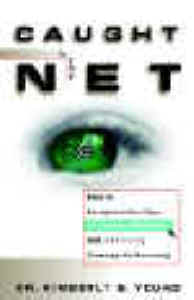Caught in the Net Table of Contents

Caught in the Net is the first serious self-help book to address Internet addiction with translations in German, Japanese, Italian, and Danish forthcoming. The book explains the warning signs and consequences of Internet addiction. Most importantly, it offers simple, practical, and concrete recovery strategies to help you deal with addictive use of the Internet at home, work, or school. Not only is the book suitable for Internet addicts themselves, but it is written for partners and parents of addicts, mental health practitioners, educators, and business executives.
Table of Contents
Introduction: A Controversial New Addiction
Chapter 1: The Dark Side of Cyberspace
While our culture heralds the Internet as a technological wonder, increasing numbers of Internet users have tumbled into patterns of addictive use that trigger significant problems in their relationships and families, and at work or school. Initial examples culled from my survey offer a revealing look at this other side of cyberspace, where ordinary students, homemakers, and professionals are losing control of their Internet usage and their lives. The chapter explores why Internet addiction fits our troubled times, and invites readers to take the Internet Addiction Test to assess their own degree of potential addiction.
Chapter 2: The Terminal Time Warp
"One more minute," a typical Internet user often says to a spouse or parent who years for their attention during a long on-line session. But before they know how or why it happened, that minute invariably turns into one or more hours - at the cost of the people and activities that more and more often are ignored. This chapter illustrates what makes specific Internet applications so time consuming, and outlines time management techniques that will help users regain control of their time.
Chapter 3: Profiles of On-lineaholics
Trends in my study indicate that those most vulnerable to this obsession include women and men who already suffer from depression, anxiety, low self-esteem, or the struggles with recovery from a prior addiction. Case studies reveal how these Internet users turn to newsgroups, chat rooms, or interactive games seeking temporary relief, only to find that the old problems they've been avoiding have stuck with them, exacerbated by their addiction to the Internet. Following each case study, intervention tools and new recovery strategies point the way toward curbing excessive Internet use while addressing the real-life problems behind it.
Chapter 4: The Faceless Community
On the Internet, you can conceal your real name, age, occupation, appearance, and your physical responses to anyone or anything you encounter on-line. Internet users, especially those who are lonely and insecure in real-life situations, take that freedom and quickly pour out their strongest feelings, darkest secrets, and deepest desires. This leads to the illusion of intimacy, but when reality underscores the severe limitations of relying on a faceless community for the love and caring that can only come from actual people, Internet addicts experience very real disappointment and pain.
Chapter 5: Cyberwidows: The Victims of Terminal Love
When a husband or wife turns to the computer for intimacy and sex - sometimes even ending a long marriage to run off with their Internet lover - the cyberwidow left behind must confront rejection, abandonment, anger, and confusion about what happened and why. This chapter addresses those feelings and illustrates how the quick and easy connections made through the safety of the computer screen undermine intimate relationships at home. Readers learn the basic warning signs that may indicate their spouse has engaged in a cyberaffair, and a step-by-step- plan outlines how to approach the spouse who has strayed.
Chapter 6: Parents, Kids, and a Technological Time Bomb
A precocious twelve year old boy in Missouri is cut off from his Internet use by his parents and then kills his mother and himself - an extreme example of family strife triggered by kids who bury themselves in their computers at the expense of their grades, their hobbies, their social life, and any opportunities for honesty and trust with their parents. This chapter educates parents about how the same technological tool that President Clinton insists must be installed in every classroom all too often leads kids down a path toward the adult-like psychological and emotional problems of addiction. Parents learn how to monitor their children's Internet use and ensure that it doesn't become a source of wasted time, distraction, and obsessive behavior more pervasive and destructive to young minds and psyches than television.
Chapter 7: Fraternities of Netheads
Walk by any college computer labs late at night and you'll see hundreds of students frantically typing away on their computer terminals - but instead of school research and paper-writing, they're most likely spending several hours every night slaying monsters in MUDs or chatting aimlessly with Internet pals hundreds of miles or even continents away. This chapter reveals how the combination of unstructured and free, unlimited Internet use breed college communities of severe addicts, who are just beginning to awaken to the seriousness of plummeting grades and ruined social lives. Case studies, observations, and suggestions for a new outlook on the Internet in our universities serve as a wake-up call to students, faculty, parents, and counselors.
Chapter 8: No Work Today - Everybody's Gone Surfin'
Employees with Internet access on the job are abusing the privilege by spending hours sending and receiving personal email, perusing newsgroups, socializing in chat rooms, and playing interactive games. Managers either know or suspect what's happening, which leads to computer-related firings and a growing climate of misunderstanding and distrust. This chapter shares the attitudes, experiences, and perspectives of both sides of the office environment and presents a blueprint for managing this escalating issue with greater awareness and sensitivity.
Chapter 9: Staying On Track
Unlike physical addictions like alcoholism, Internet addiction does not require abstinence for a healthy and life-enhancing recovery. Building on the many suggestions and tools of moderation outlined in the Recovery Strategy woven throughout previous chapters, this final section ties it all together to make clear to Internet addicts and their families how they now can use the Net without abusing it. Special emphasis is given to additional outside resources that are becoming available to treat this addiction and which can help Internet junkies stay on track in the months and years ahead.
next: Introduction to "Caught on the Net"
~ all center for online addiction articles
~ all articles on addictions
APA Reference
Staff, H.
(2008, December 15). Caught in the Net Table of Contents, HealthyPlace. Retrieved
on 2024, June 20 from https://www.healthyplace.com/addictions/center-for-internet-addiction-recovery/caught-in-the-net-toc
